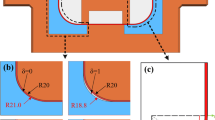Abstract
In this study, a 2D finite-element model of electromagnetic impulse calibration was established to understand the mechanistic of springback correction. According to the results both in experiment and simulation, the springback angle after the coil discharging sharply decreases in comparison with quasi-static stamping, and the springback angle decreases gradually with the increasement in discharging energy. Finally, negative springback under the 6-KJ condition both occur in experimental and simulation results. It was found the sheet corner moves far away from punch by magnetic force and the inertial effect caused by magnetic force firstly. When the sheet peak reaches the maximum position, the sheet corner immediately reverse bending and moves closer to the punch. The phenomenon of reverse bending generates additional tangential stress in opposite direction, which decreases the original tangential stress on sheet corner and even makes the sheet corner undergo plastic deformation in high discharge energy. The discoveries showed in this paper will provide theoretical basis for controlling the springback of complex parts in the future.
Similar content being viewed by others
References
Imbert JM, Winkler SL, Worswick MJ, Oliveira DA, Golovashchenko S (2005) The effect of tool-sheet interaction on damage evolution in electromagnetic forming of aluminum alloy sheet. J Eng Mater Technol 127:145–153
Psyk V, Risch D, Kinsey BL, Tekkaya AE, Kleiner M (2011) Electromagnetic forming—a review. J Mater Process Technol 211:787–829
Golovashchenko S (2006) Electromagnetic forming and joining for automotive applications. 2nd International Conference on high speed forming, pp 201–206
Woodward S, Weddeling C, Daehn G, Psyk V, Carson B, Tekkaya AE (2010) Agile production of sheet metal aviation components using disposable electromagnetic actuators. 4th International Conference on High Speed Forming, pp 35–46
Cai H (2012) Experimental study of electromagnetic forming in springback of aluminum alloy curved surface. Master Degree, Thesis, Wuhan University of Technology
Iriondo E, Gutiérrez MA, González B, Alcaraz JL, Daehn GS (2011) Electromagnetic impulse calibration of high strength sheet metal structures. J Mater Process Technol 211:909–915
Iriondo E, Alcaraz JL, Daehn GS, Gutiérrez MA, Jimbert P (2013) Shape calibration of high strength metal sheets by electromagnetic forming. J Manuf Process 15:183–193
Liu DH, Zhou WH, Li CF (2013) Springback control and deformation analysis for electromagnetically assisted bending of U-shaped parts. Chin J Nonferrous Met 11:3075–3082
Shang JH (2006) Electromagnetically assisted sheet metal stamping. Thesis, The Ohio State University, Columbus, Doctor Degree
Cui XH, Mo JH, Li JJ, Yu HL, Wang QS (2017) Reduction of springback in V-shaped parts using electromagnetic impulse calibration. Procedia Engineering 207:801–806
Cui XH, Mo JH, Li JJ, Xiao XT, Zhou B, Fang JX (2016) Large-scale sheet deformation process by electromagnetic incremental forming combined with stretch forming. J Mater Process Technol 237:139–154
Li FQ, Mo JH, Li JJ, Zhou HY, Huang L (2013) Study on the driver plate for electromagnetic forming of titanium alloy Ti-6Al-4V. Int J Adv Manuf Technol 69:127–137
Li FQ, Mo JH, Li JJ, Zhao J (2017) Formability evaluation for low conductive sheet metal by novel specimen design in electromagnetic forming. Int J Adv Manuf Technol 88:1677–1685
Li N, Yu HP, Xu Z, Fan ZX, Liu L (2016) Electromagnetic forming facilitates the transition of deformation mechanism in 5052 aluminum alloy. Mater Sci Eng A 673:222–232
Li GY, Deng HK, Mao YF, Zhang X, Cui JJ (2018) Study on AA5182 aluminum sheet formability using combined quasi-staticdynamic tensile processes. J Mater Process Technol 255:373–386
Lesuer D (1999) Experimental investigations of material models for Ti–6AL4V and 2024-T3. U.S. Department of Energy
Funding
This work was supported by the National Natural Science Foundation of China (Grant Nos. 51775563 and 51405173); the State Key Laboratory of Materials Processing and Die & Mold Technology, Huazhong University of Science and Technology (No.P2017-013); the Project of State Key Laboratory of High Performance Complex Manufacturing, Central South University (ZZYJKT2017-03); and Guangzhou Science and Technology Plan Project (201707010472).
Author information
Authors and Affiliations
Corresponding author
Rights and permissions
About this article
Cite this article
Cui, X., Yu, H. & Wang, Q. Electromagnetic impulse calibration in V-shaped parts. Int J Adv Manuf Technol 97, 2959–2968 (2018). https://doi.org/10.1007/s00170-018-2108-5
Received:
Accepted:
Published:
Issue Date:
DOI: https://doi.org/10.1007/s00170-018-2108-5



